“Ransomware detected” virus (Support Scam) - Virus Removal Instructions
“Ransomware detected” virus Removal Guide
What is “Ransomware detected” virus?
“Ransomware detected” pretends to be a legit security notification
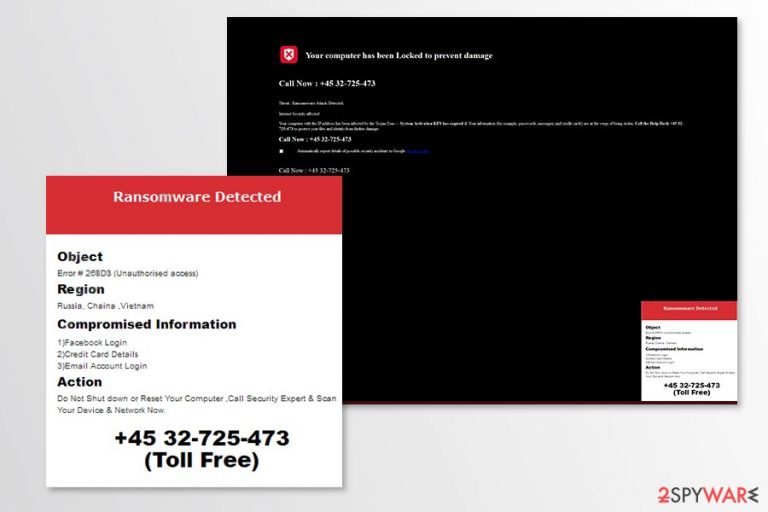
“Ransomware detected” is a fake security alert that warns about detected ransomware on the computer. People are urged to call a toll-free phone number (+45 32-725-473) to the security experts who will provide a malware removal tool. However, neither the error nor the phone number should be trusted.
“Ransomware detected” virus is another example of Microsoft support scam.[1] This error message is triggered by a potentially unwanted program (PUP), usually adware. This application might sneak inside the computer unnoticed in a software bundle. Once inside it starts delivering fake antivirus pop-ups.
However, once you read the alert carefully, you will see that it’s not hard to recognize scammers. The alert warns about ransomware attack, but the contents warn about lost sensitive data instead of encrypted files. Indeed, that’s illogical. Besides, you mistakes left in the alert reveal criminals too:
Ransomware Detected
Object
Error #268D3 (Unauthorised access)Region
Russia, Chaina, VietnamCompromised Information
1)Facebook Login
2)Credit Card Details
3)Email Account LoginAction
Do Not Show down or Reset Your Computer ,Call Security Expert & Scan Your Device & Network Now.+45 32-725-473
(Toll Free)
“Ransomware detected” technical support scam informs about Error #268D3. However, it’s another fake error message which has been previously used by scammers and known under the name of “Error #268D3” virus.[2] Assuming from the message’s content, crooks aim at computer users in Russia,[3] China, and Vietnam.
This example of technical support scam barely differs from other cyber frauds. Criminals want to make users believe that their personal information is compromised and only “certified” specialists can help to fix the problem. However, calling them might end up with an installation of bogus security software and even bigger problems, such as money loss or installation of malware.
We highly recommend checking your computer’s state as soon as this suspicious alert shows up on your screen. To remove “Ransomware detected” malware from the PC quickly, you should employ professional anti-malware/anti-spyware and run a full system scan for it. If you are not sure which tool to choose, we suggest FortectIntego.
Additionally, you can opt for the manual “Ransomware detected” removal. Usually, this scam is triggered by a particular PUP, so you have to find and eliminate it. The instructions provided at the end of the article will help you to complete this task.
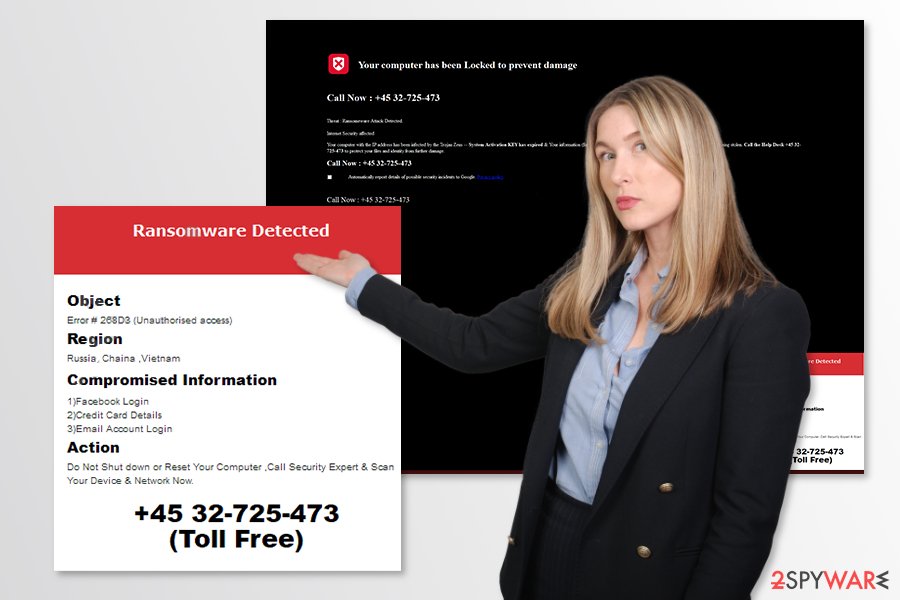
Advanced freeware installation settings can prevent from PUP installation
Most of the time scammers employ adware programs to spread similar cyber threats. Often these PUPs are presented as useful tools and offered to download in software packages. However, if you do not pay attention to this process, you might install suspicious apps unintentionally. To avoid that, you should:
- Always choose Advanced/Custom settings instead of Quick/Recommended.
- Read EULA, Privacy Policy and information provided in the installation wizard.
- Unmark pre-selected apps and agreements to change your search provider.
Fighting “Ransomware detected” virus
In order to remove “Ransomware detected” pop-ups, you have to find the source of the problem. As we have mentioned, it might be a potentially unwanted program which was installed to your PC or web browser. Therefore, you should follow the guide below and get rid of it.
But you can also speed up “Ransomware detected” removal with anti-malware software. These misleading alerts should be gone as soon as you complete a full system scan with an updated tool.
You may remove virus damage with a help of FortectIntego. SpyHunter 5Combo Cleaner and Malwarebytes are recommended to detect potentially unwanted programs and viruses with all their files and registry entries that are related to them.
Getting rid of “Ransomware detected” virus. Follow these steps
Uninstall from Windows
These instructions will help you to remove potentially unwnated program which is most likely to spread scam:
Instructions for Windows 10/8 machines:
- Enter Control Panel into Windows search box and hit Enter or click on the search result.
- Under Programs, select Uninstall a program.

- From the list, find the entry of the suspicious program.
- Right-click on the application and select Uninstall.
- If User Account Control shows up, click Yes.
- Wait till uninstallation process is complete and click OK.

If you are Windows 7/XP user, proceed with the following instructions:
- Click on Windows Start > Control Panel located on the right pane (if you are Windows XP user, click on Add/Remove Programs).
- In Control Panel, select Programs > Uninstall a program.

- Pick the unwanted application by clicking on it once.
- At the top, click Uninstall/Change.
- In the confirmation prompt, pick Yes.
- Click OK once the removal process is finished.
Delete from macOS
Remove items from Applications folder:
- From the menu bar, select Go > Applications.
- In the Applications folder, look for all related entries.
- Click on the app and drag it to Trash (or right-click and pick Move to Trash)

To fully remove an unwanted app, you need to access Application Support, LaunchAgents, and LaunchDaemons folders and delete relevant files:
- Select Go > Go to Folder.
- Enter /Library/Application Support and click Go or press Enter.
- In the Application Support folder, look for any dubious entries and then delete them.
- Now enter /Library/LaunchAgents and /Library/LaunchDaemons folders the same way and terminate all the related .plist files.

Remove from Microsoft Edge
Fix Microsoft Edge to stop receivig fake security alerts:
Delete unwanted extensions from MS Edge:
- Select Menu (three horizontal dots at the top-right of the browser window) and pick Extensions.
- From the list, pick the extension and click on the Gear icon.
- Click on Uninstall at the bottom.
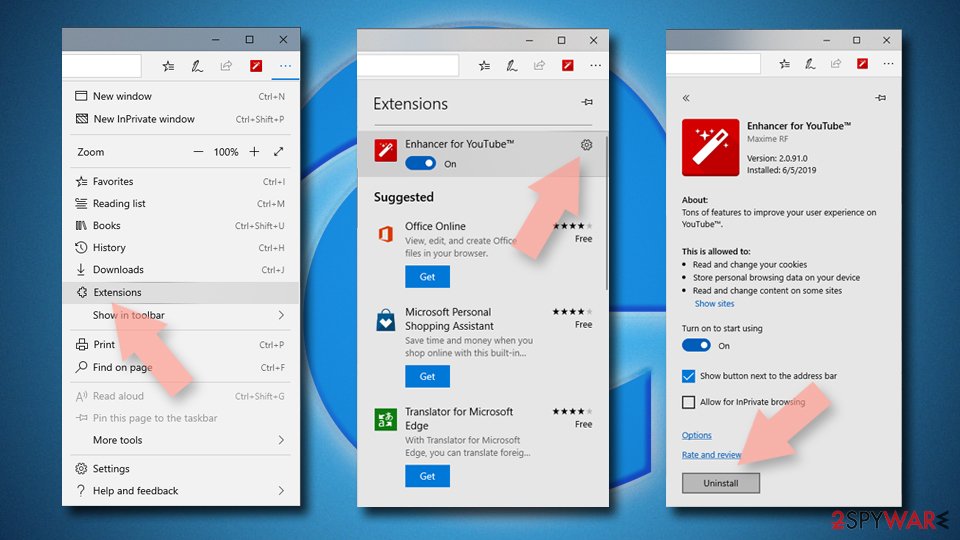
Clear cookies and other browser data:
- Click on the Menu (three horizontal dots at the top-right of the browser window) and select Privacy & security.
- Under Clear browsing data, pick Choose what to clear.
- Select everything (apart from passwords, although you might want to include Media licenses as well, if applicable) and click on Clear.
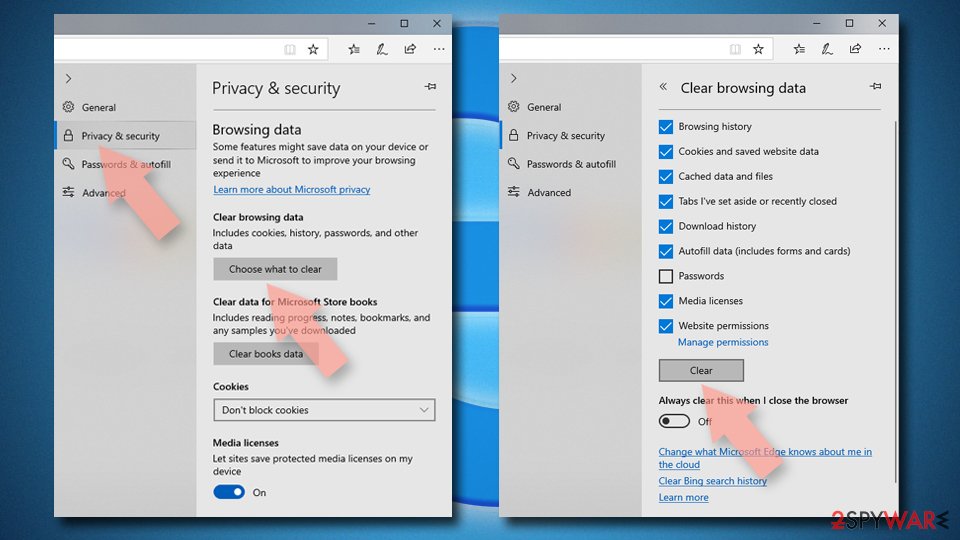
Restore new tab and homepage settings:
- Click the menu icon and choose Settings.
- Then find On startup section.
- Click Disable if you found any suspicious domain.
Reset MS Edge if the above steps did not work:
- Press on Ctrl + Shift + Esc to open Task Manager.
- Click on More details arrow at the bottom of the window.
- Select Details tab.
- Now scroll down and locate every entry with Microsoft Edge name in it. Right-click on each of them and select End Task to stop MS Edge from running.
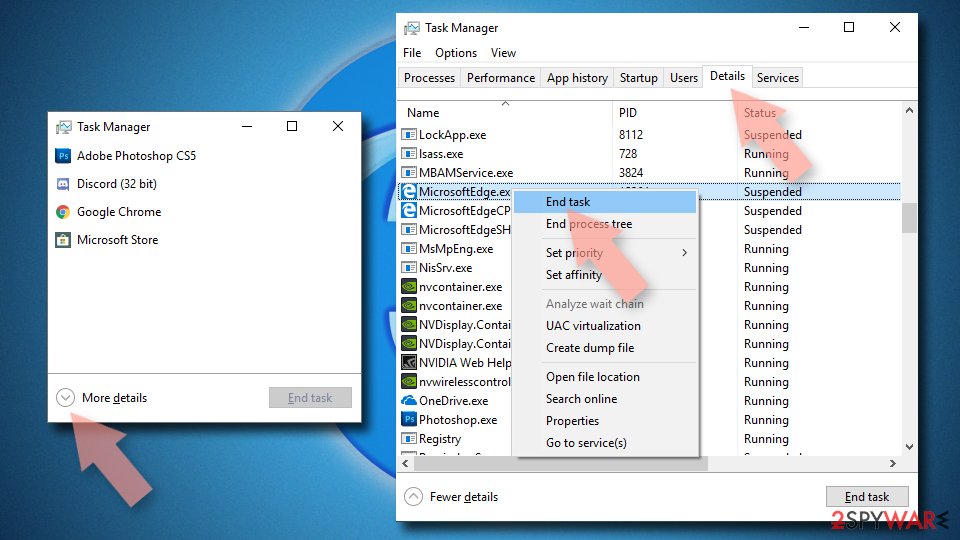
If this solution failed to help you, you need to use an advanced Edge reset method. Note that you need to backup your data before proceeding.
- Find the following folder on your computer: C:\\Users\\%username%\\AppData\\Local\\Packages\\Microsoft.MicrosoftEdge_8wekyb3d8bbwe.
- Press Ctrl + A on your keyboard to select all folders.
- Right-click on them and pick Delete

- Now right-click on the Start button and pick Windows PowerShell (Admin).
- When the new window opens, copy and paste the following command, and then press Enter:
Get-AppXPackage -AllUsers -Name Microsoft.MicrosoftEdge | Foreach {Add-AppxPackage -DisableDevelopmentMode -Register “$($_.InstallLocation)\\AppXManifest.xml” -Verbose

Instructions for Chromium-based Edge
Delete extensions from MS Edge (Chromium):
- Open Edge and click select Settings > Extensions.
- Delete unwanted extensions by clicking Remove.
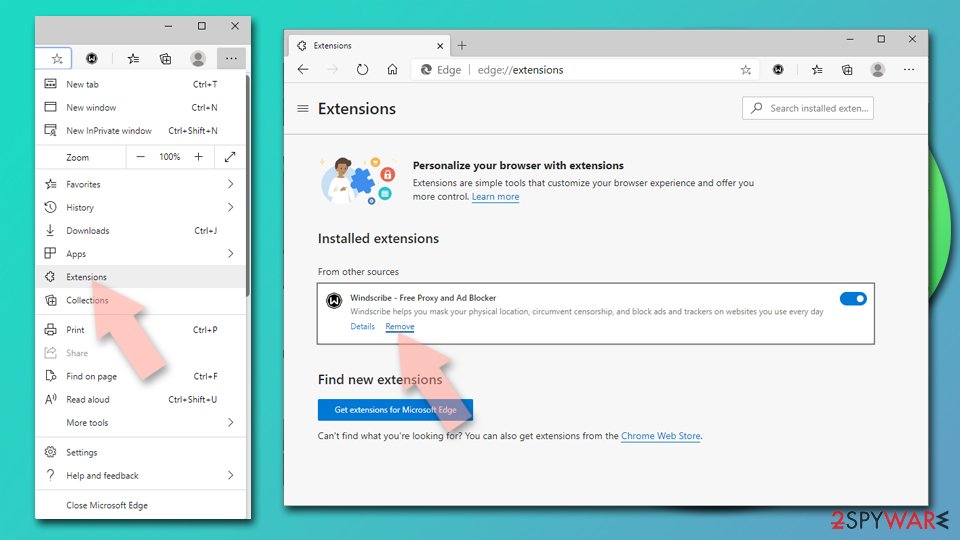
Clear cache and site data:
- Click on Menu and go to Settings.
- Select Privacy, search and services.
- Under Clear browsing data, pick Choose what to clear.
- Under Time range, pick All time.
- Select Clear now.
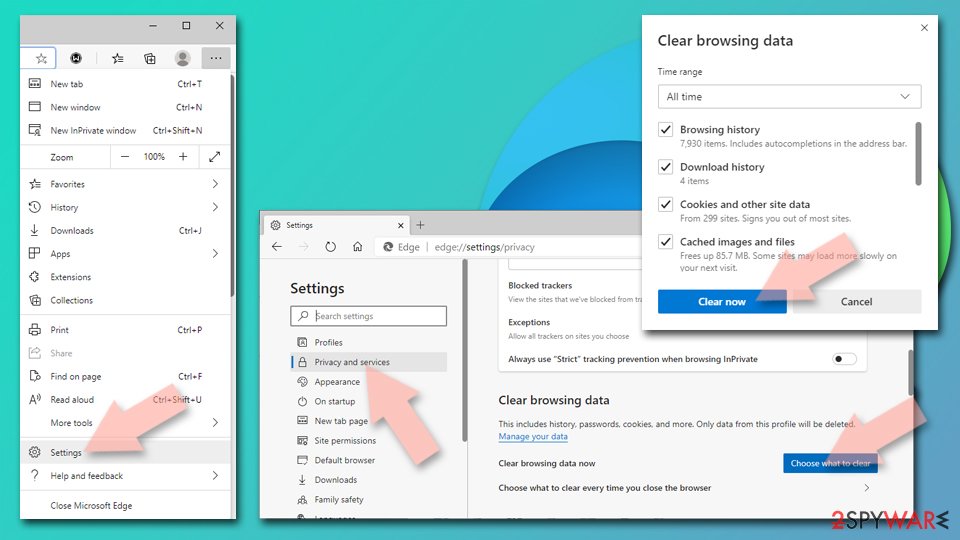
Reset Chromium-based MS Edge:
- Click on Menu and select Settings.
- On the left side, pick Reset settings.
- Select Restore settings to their default values.
- Confirm with Reset.
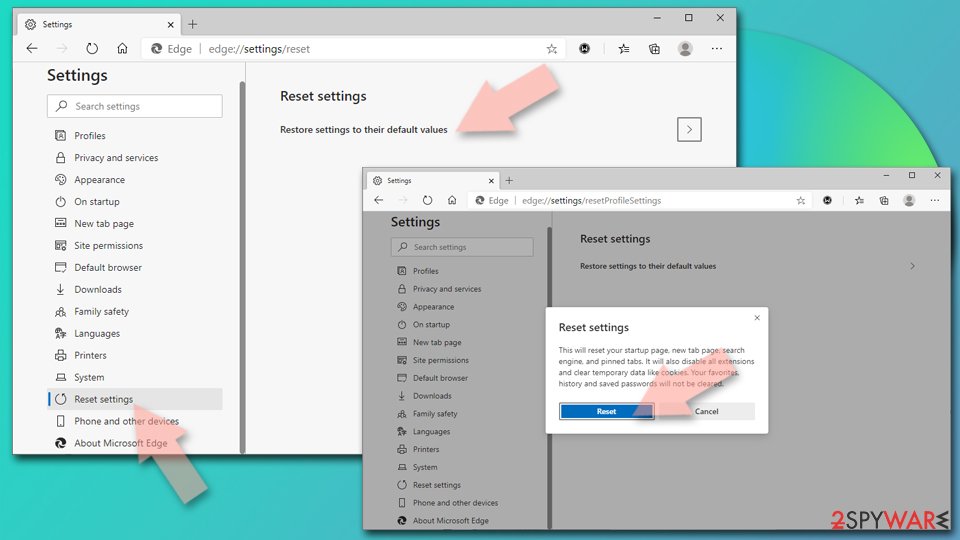
Remove from Mozilla Firefox (FF)
Uninstall suspicious add-ons and reset Mozilla Firefox to get rid of “Ransomware detected” technical support scam.
Remove dangerous extensions:
- Open Mozilla Firefox browser and click on the Menu (three horizontal lines at the top-right of the window).
- Select Add-ons.
- In here, select unwanted plugin and click Remove.

Reset the homepage:
- Click three horizontal lines at the top right corner to open the menu.
- Choose Options.
- Under Home options, enter your preferred site that will open every time you newly open the Mozilla Firefox.
Clear cookies and site data:
- Click Menu and pick Settings.
- Go to Privacy & Security section.
- Scroll down to locate Cookies and Site Data.
- Click on Clear Data…
- Select Cookies and Site Data, as well as Cached Web Content and press Clear.
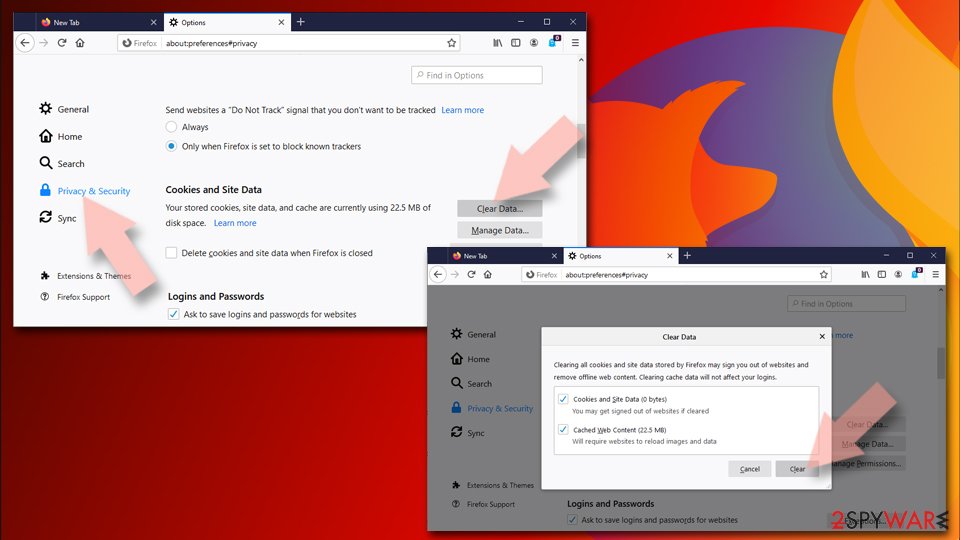
Reset Mozilla Firefox
If clearing the browser as explained above did not help, reset Mozilla Firefox:
- Open Mozilla Firefox browser and click the Menu.
- Go to Help and then choose Troubleshooting Information.
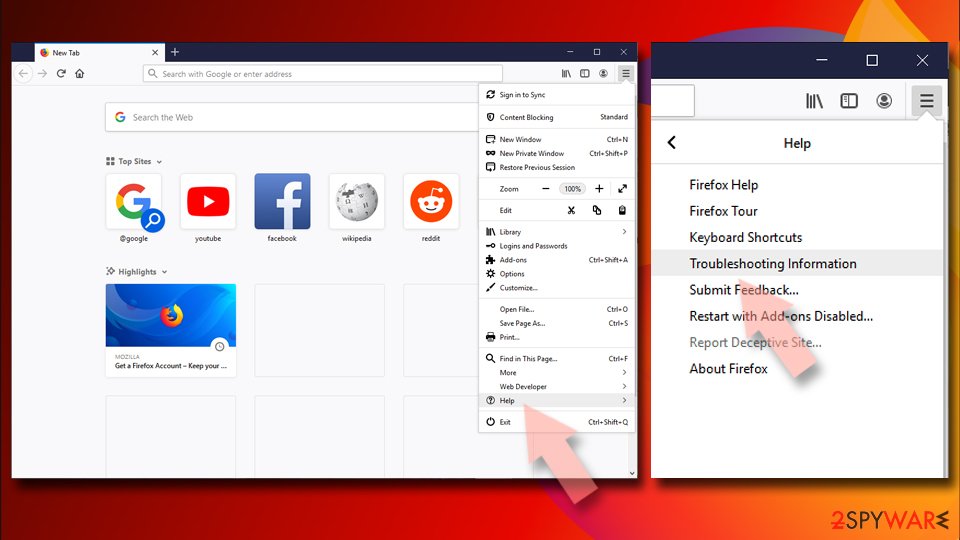
- Under Give Firefox a tune up section, click on Refresh Firefox…
- Once the pop-up shows up, confirm the action by pressing on Refresh Firefox.
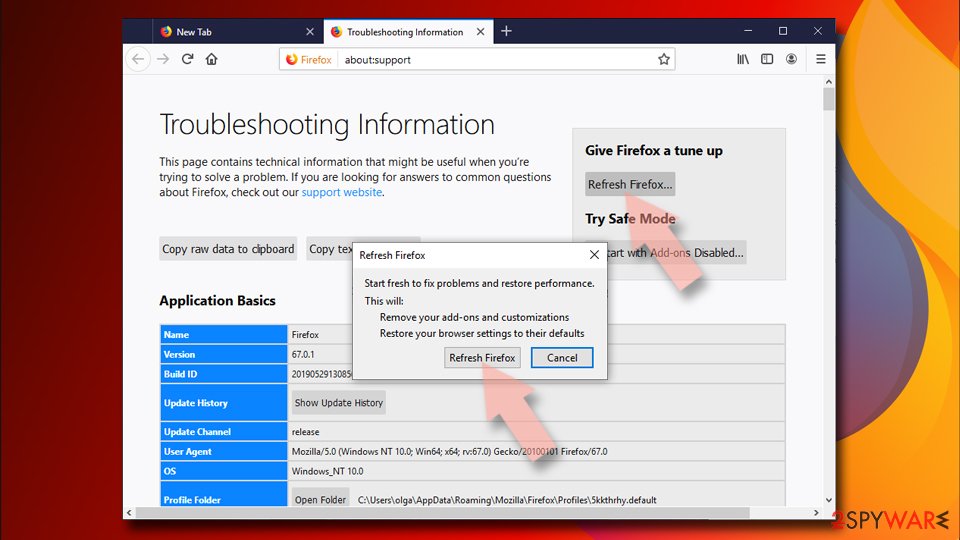
Remove from Google Chrome
These steps will help you to eliminte “Ransomware detected” PUP from Google Chrome:
Delete malicious extensions from Google Chrome:
- Open Google Chrome, click on the Menu (three vertical dots at the top-right corner) and select More tools > Extensions.
- In the newly opened window, you will see all the installed extensions. Uninstall all the suspicious plugins that might be related to the unwanted program by clicking Remove.

Clear cache and web data from Chrome:
- Click on Menu and pick Settings.
- Under Privacy and security, select Clear browsing data.
- Select Browsing history, Cookies and other site data, as well as Cached images and files.
- Click Clear data.

Change your homepage:
- Click menu and choose Settings.
- Look for a suspicious site in the On startup section.
- Click on Open a specific or set of pages and click on three dots to find the Remove option.
Reset Google Chrome:
If the previous methods did not help you, reset Google Chrome to eliminate all the unwanted components:
- Click on Menu and select Settings.
- In the Settings, scroll down and click Advanced.
- Scroll down and locate Reset and clean up section.
- Now click Restore settings to their original defaults.
- Confirm with Reset settings.
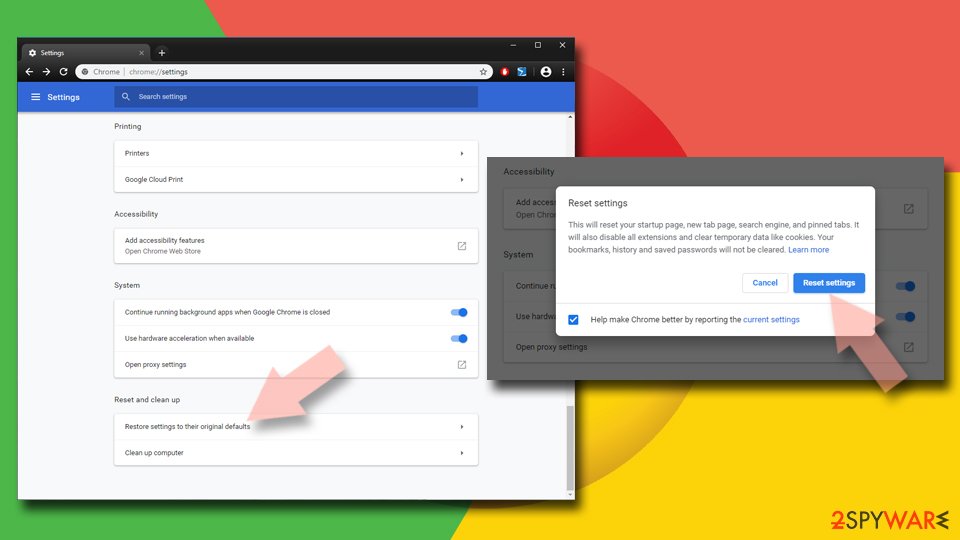
Delete from Safari
Remove unwanted extensions from Safari:
- Click Safari > Preferences…
- In the new window, pick Extensions.
- Select the unwanted extension and select Uninstall.
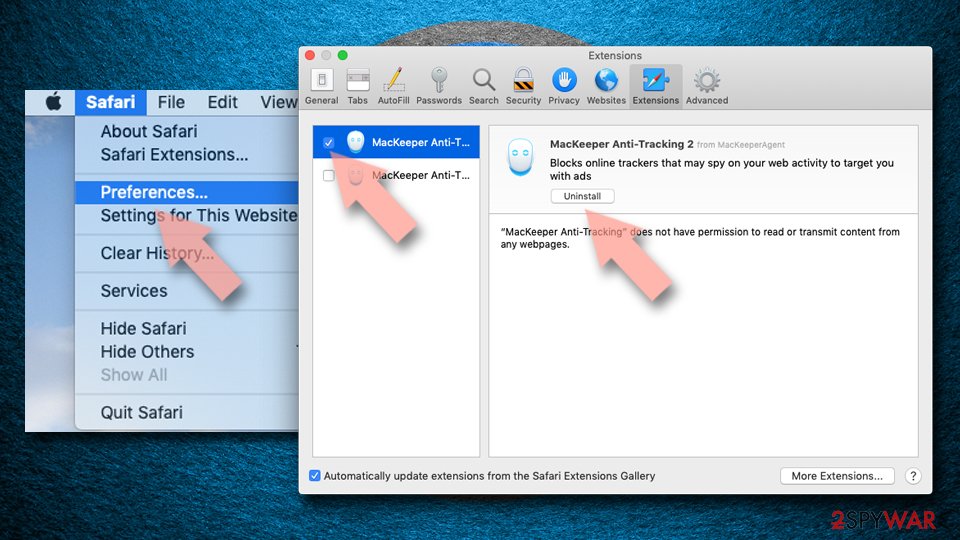
Clear cookies and other website data from Safari:
- Click Safari > Clear History…
- From the drop-down menu under Clear, pick all history.
- Confirm with Clear History.
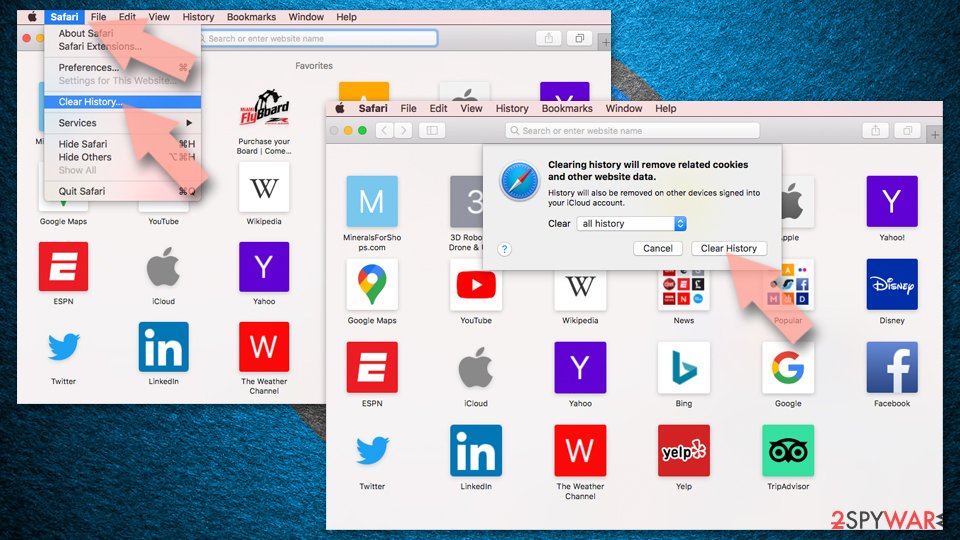
Reset Safari if the above-mentioned steps did not help you:
- Click Safari > Preferences…
- Go to Advanced tab.
- Tick the Show Develop menu in menu bar.
- From the menu bar, click Develop, and then select Empty Caches.
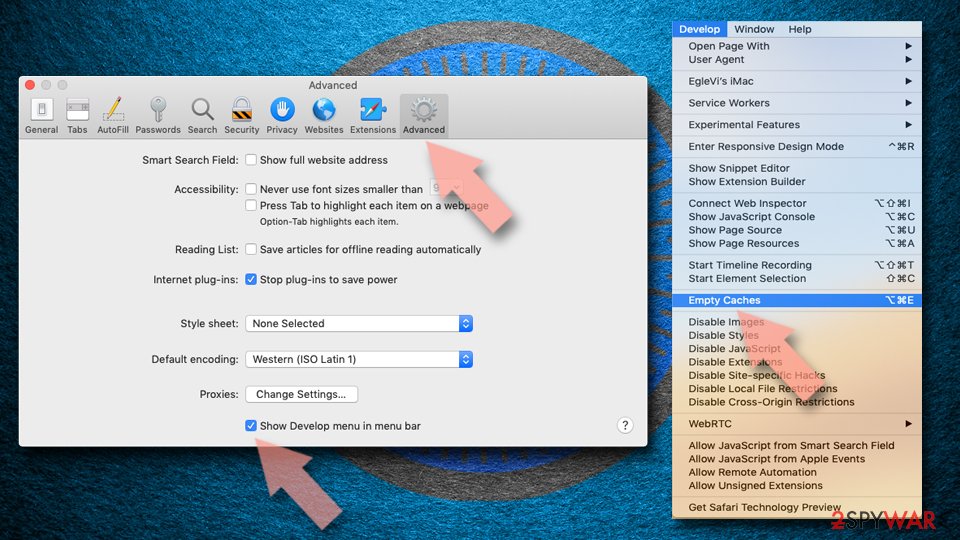
After uninstalling this potentially unwanted program (PUP) and fixing each of your web browsers, we recommend you to scan your PC system with a reputable anti-spyware. This will help you to get rid of “Ransomware detected” registry traces and will also identify related parasites or possible malware infections on your computer. For that you can use our top-rated malware remover: FortectIntego, SpyHunter 5Combo Cleaner or Malwarebytes.
How to prevent from getting adware
Stream videos without limitations, no matter where you are
There are multiple parties that could find out almost anything about you by checking your online activity. While this is highly unlikely, advertisers and tech companies are constantly tracking you online. The first step to privacy should be a secure browser that focuses on tracker reduction to a minimum.
Even if you employ a secure browser, you will not be able to access websites that are restricted due to local government laws or other reasons. In other words, you may not be able to stream Disney+ or US-based Netflix in some countries. To bypass these restrictions, you can employ a powerful Private Internet Access VPN, which provides dedicated servers for torrenting and streaming, not slowing you down in the process.
Data backups are important – recover your lost files
Ransomware is one of the biggest threats to personal data. Once it is executed on a machine, it launches a sophisticated encryption algorithm that locks all your files, although it does not destroy them. The most common misconception is that anti-malware software can return files to their previous states. This is not true, however, and data remains locked after the malicious payload is deleted.
While regular data backups are the only secure method to recover your files after a ransomware attack, tools such as Data Recovery Pro can also be effective and restore at least some of your lost data.
- ^ Tech support scams. Microsoft. The official website.
- ^ Jake Doe. How to Fix Error # 268D3?. Ugetfix. How to fix a computer.
- ^ Bedynet. Bedynet. Russian cyber security news.
